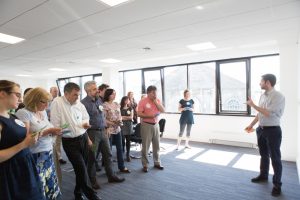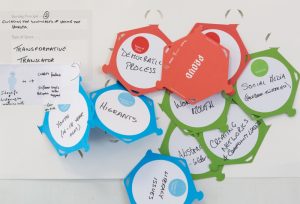There are many criteria on which you can challenge an organisation to be creative. They include leadership; external and internal networking; systems and processes; inclusivity and flat structures; a commitment to translate creative thought into practice (innovation) and ‘creative spaces’.
This last gives rise – in me, anyway – to covetous thoughts of Google-style playrooms for professionals. The kinds of things we are now seeing in both design hotels and cool tech offices; slides, coloured design furniture, bowling alleys, lickable wallpaper…or was that Charlie and the Chocolate Factory? I imagine there is always great coffee and a bespoke Sushi outlet. These places look lovely but there is something in them that makes me think if I’m not immediately bursting with AMAZING ideas then I’ve somehow failed. Too much pressure?
These spaces can certainly encourage thinking without boundaries – but I considered throughout Participation Week how important they are. And what do we mean by creative space? Emma Barrett, who runs SILK (Social Inclusion Lab Kent) considers the whole of the county as a creative space – and I’m pretty sure they haven’t turned Kent into a paint advert. What she means is the way in which we enter into, engage with and behave in the space.
Pop up spaces are similarly popular just now. Is this the answer to creative spaces? So instead of inviting people to an office, you decide to make an existing space creative. The spaces follow the people, not vice versa, and they can as easily appear as disappear. These are a great idea, flexible, and as long as you have a really good case to hold your tools, means of transportation, willing helpers and time to clear up they can be vital and responsive.
Do we combine functions – go to where people already are? There is a ton of evidence about the benefits of using libraries more imaginatively, and some great examples in the UK. When we go to a club night in our local museum it completely transforms the space, and therefore how we think in it. Again, the benefit here is that you are going to where people are, not the other way round. One observation has been that ‘hard to reach’ really just means ‘hard to listen to’.
Guest Blog: in a joint event by the Leapfrog and Ideas projects we explored the notion of the Ting as a new creative space. As part of this we invited Anna Winters, head og the Scotish Goverments creativity team to write about democratic spaces.
It is not imperative to have sticky walls to be creative – just ask the myriad community groups who have changed the world from a run-down housing estate – but tools do help. The sorts of tools that ImaginationLancaster develop, where you can see people’s eyes light up as soon as they see the sets of beautifully designed stickers that in half an hour will help articulate the idea you and a bunch of strangers just came up with for a great new approach to engaging with citizens on policy. People feel special and they want to use this stuff.
But without the right mindsets; challenging our assumptions; taking real care to understand and empathise with other viewpoints (especially the ones we really don’t agree with), lickable wallpaper won’t help. Simon Burral from Involve UK had encouraged us “Don’t start with the tools, start with the intent” – once you have agreed how and to what extent you can influence something, the tools can make it a pleasure to turn aspiration into reality. And a welcoming space, however it is configured, will definitely help things along.



